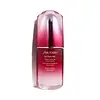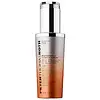What's inside
What's inside
 Key Ingredients
Key Ingredients

 Benefits
Benefits

 Concerns
Concerns

 Ingredients Side-by-side
Ingredients Side-by-side

Water
Skin ConditioningAlcohol Denat.
AntimicrobialGlycerin
HumectantButylene Glycol
HumectantPEG/PPG-17/4 Dimethyl Ether
Skin ConditioningTriethylhexanoin
MaskingCyclohexasiloxane
EmollientDimethicone
EmollientPhenoxyethanol
PreservativeTrehalose
HumectantAmmonium Acryloyldimethyltaurate/Beheneth-25 Methacrylate Crosspolymer
Emulsion StabilisingPEG-14m
Emulsion StabilisingAcrylates/C10-30 Alkyl Acrylate Crosspolymer
Emulsion StabilisingTocopheryl Acetate
AntioxidantPEG/PPG-14/7 Dimethyl Ether
Skin ConditioningRosa Damascena Flower Water
MaskingParfum
MaskingDisodium EDTA
Potassium Hydroxide
BufferingSilica
AbrasiveIsoceteth-10
EmulsifyingLinalool
PerfumingLauryl Betaine
CleansingGinkgo Biloba Leaf Extract
Skin ConditioningGeraniol
PerfumingCitronellol
PerfumingOriganum Majorana Leaf Extract
AntiseborrhoeicNelumbo Nucifera Germ Extract
Skin ConditioningAlcohol
AntimicrobialSodium Carboxymethyl Beta-Glucan
CleansingBHT
AntioxidantThymus Serpyllum Extract
Skin ConditioningPerilla Ocymoides Leaf Extract
TonicSodium Bicarbonate
AbrasiveIris Florentina Root Extract
MaskingSodium Benzoate
MaskingGanoderma Lucidum Stem Extract
Skin ConditioningWater, Alcohol Denat., Glycerin, Butylene Glycol, PEG/PPG-17/4 Dimethyl Ether, Triethylhexanoin, Cyclohexasiloxane, Dimethicone, Phenoxyethanol, Trehalose, Ammonium Acryloyldimethyltaurate/Beheneth-25 Methacrylate Crosspolymer, PEG-14m, Acrylates/C10-30 Alkyl Acrylate Crosspolymer, Tocopheryl Acetate, PEG/PPG-14/7 Dimethyl Ether, Rosa Damascena Flower Water, Parfum, Disodium EDTA, Potassium Hydroxide, Silica, Isoceteth-10, Linalool, Lauryl Betaine, Ginkgo Biloba Leaf Extract, Geraniol, Citronellol, Origanum Majorana Leaf Extract, Nelumbo Nucifera Germ Extract, Alcohol, Sodium Carboxymethyl Beta-Glucan, BHT, Thymus Serpyllum Extract, Perilla Ocymoides Leaf Extract, Sodium Bicarbonate, Iris Florentina Root Extract, Sodium Benzoate, Ganoderma Lucidum Stem Extract
Water
Skin ConditioningTetrahexyldecyl Ascorbate
AntioxidantButylene Glycol
HumectantC9-12 Alkane
SolventCaprylyl Methicone
Skin ConditioningTocopheryl Acetate
AntioxidantC10-18 Triglycerides
EmollientPolyglyceryl-6 Distearate
EmulsifyingFerulic Acid
AntimicrobialSqualane
EmollientHydrogenated Lecithin
EmulsifyingPropanediol
SolventSodium Hyaluronate
HumectantZingiber Officinale Root Extract
MaskingCurcuma Longa Root Extract
MaskingPanax Ginseng Root Extract
EmollientJojoba Esters
EmollientLeuconostoc/Radish Root Ferment Filtrate
AntimicrobialCoco-Caprylate/Caprate
EmollientGlycerin
HumectantCetyl Alcohol
EmollientPolyglyceryl-3 Beeswax
EmulsifyingXanthan Gum
EmulsifyingDisodium EDTA
Mica
Cosmetic ColorantEthylhexylglycerin
Skin ConditioningPotassium Sorbate
PreservativeSodium Benzoate
MaskingPhenoxyethanol
PreservativeWater, Tetrahexyldecyl Ascorbate, Butylene Glycol, C9-12 Alkane, Caprylyl Methicone, Tocopheryl Acetate, C10-18 Triglycerides, Polyglyceryl-6 Distearate, Ferulic Acid, Squalane, Hydrogenated Lecithin, Propanediol, Sodium Hyaluronate, Zingiber Officinale Root Extract, Curcuma Longa Root Extract, Panax Ginseng Root Extract, Jojoba Esters, Leuconostoc/Radish Root Ferment Filtrate, Coco-Caprylate/Caprate, Glycerin, Cetyl Alcohol, Polyglyceryl-3 Beeswax, Xanthan Gum, Disodium EDTA, Mica, Ethylhexylglycerin, Potassium Sorbate, Sodium Benzoate, Phenoxyethanol
 Reviews
Reviews

Ingredients Explained
These ingredients are found in both products.
Ingredients higher up in an ingredient list are typically present in a larger amount.
Butylene Glycol (or BG) is used within cosmetic products for a few different reasons:
Overall, Butylene Glycol is a safe and well-rounded ingredient that works well with other ingredients.
Though this ingredient works well with most skin types, some people with sensitive skin may experience a reaction such as allergic rashes, closed comedones, or itchiness.
Learn more about Butylene GlycolDisodium EDTA plays a role in making products more stable by aiding other preservatives.
It is a chelating agent, meaning it neutralizes metal ions that may be found in a product.
Disodium EDTA is a salt of edetic acid and is found to be safe in cosmetic ingredients.
Learn more about Disodium EDTAGlycerin is already naturally found in your skin. It helps moisturize and protect your skin.
A study from 2016 found glycerin to be more effective as a humectant than AHAs and hyaluronic acid.
As a humectant, it helps the skin stay hydrated by pulling moisture to your skin. The low molecular weight of glycerin allows it to pull moisture into the deeper layers of your skin.
Hydrated skin improves your skin barrier; Your skin barrier helps protect against irritants and bacteria.
Glycerin has also been found to have antimicrobial and antiviral properties. Due to these properties, glycerin is often used in wound and burn treatments.
In cosmetics, glycerin is usually derived from plants such as soybean or palm. However, it can also be sourced from animals, such as tallow or animal fat.
This ingredient is organic, colorless, odorless, and non-toxic.
Glycerin is the name for this ingredient in American English. British English uses Glycerol/Glycerine.
Learn more about GlycerinPhenoxyethanol is a preservative that has germicide, antimicrobial, and aromatic properties. Studies show that phenoxyethanol can prevent microbial growth. By itself, it has a scent that is similar to that of a rose.
It's often used in formulations along with Caprylyl Glycol to preserve the shelf life of products.
Sodium Benzoate is a preservative. It's used in both cosmetic and food products to inhibit the growth of mold and bacteria. It is typically produced synthetically.
Both the US FDA and EU Health Committee have approved the use of sodium benzoate. In the US, levels of 0.1% (of the total product) are allowed.
Sodium benzoate works as a preservative by inhibiting the growth of bacteria inside of cells. It prevents the cell from fermenting a type of sugar using an enzyme called phosphofructokinase.
It is the salt of benzoic acid. Foods containing sodium benzoate include soda, salad dressings, condiments, fruit juices, wines, and snack foods.
Studies for using ascorbic acid and sodium benzoate in cosmetics are lacking, especially in skincare routines with multiple steps.
We always recommend speaking with a professional, such as a dermatologist, if you have any concerns.
Learn more about Sodium BenzoateTocopheryl Acetate is AKA Vitamin E. It is an antioxidant and protects your skin from free radicals. Free radicals damage the skin by breaking down collagen.
One study found using Tocopheryl Acetate with Vitamin C decreased the number of sunburned cells.
Tocopheryl Acetate is commonly found in both skincare and dietary supplements.
Learn more about Tocopheryl AcetateWater. It's the most common cosmetic ingredient of all. You'll usually see it at the top of ingredient lists, meaning that it makes up the largest part of the product.
So why is it so popular? Water most often acts as a solvent - this means that it helps dissolve other ingredients into the formulation.
You'll also recognize water as that liquid we all need to stay alive. If you see this, drink a glass of water. Stay hydrated!
Learn more about Water